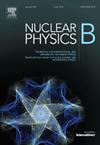Wormhole thermodynamics in matter-geometry coupled theory: Implications of pseudo-isothermal profile and complexity factor
IF 2.5
3区 物理与天体物理
Q2 PHYSICS, PARTICLES & FIELDS
引用次数: 0
Abstract
The objective of this article is to explore the existence of traversable wormholes possessing the pseudo-isothermal profile in modified gravity. We utilize the Morris-Thorne spacetime to define the wormhole structure and develop anisotropic gravitational equations for a linear modified gravity model. Our analysis involves deriving the shape functions by taking into account both constant and variable redshift functions. These shape functions adhere to the required conditions and create a connection between two asymptotically flat regions of spacetime. For each of the two cases, we analyze energy conditions whose satisfaction ensures the existence of wormholes without the necessity for exotic matter. Furthermore, we evaluate the active gravitational mass, complexity factor and volume integral quantifier for the proposed solutions. It is revealed that all these quantities gain positive value at the wormhole's throat. Afterwards, a detailed stability analysis of the developed models is performed through certain criteria. We also analyze the thermodynamic behavior, focusing on the variation of entropy and its implications for the wormhole geometry. Our findings suggest that the pseudo-isothermal wormhole geometry exists in the context of the considered matter-geometry coupled modified theory.
物质-几何耦合理论中的虫洞热力学:拟等温剖面和复杂性因子的含义
本文的目的是探讨在修正的f(R,T)重力下具有伪等温剖面的可穿越虫洞的存在性。我们利用Morris-Thorne时空定义了虫洞结构,并为线性修正的引力模型建立了各向异性引力方程。我们的分析包括通过考虑恒定和可变红移函数来推导形状函数。这些形状函数符合所要求的条件,并在两个渐近平坦的时空区域之间建立了联系。对于这两种情况中的每一种,我们分析了其满足的能量条件,以确保虫洞的存在,而不需要外来物质。此外,我们还评估了所提解的主动引力质量、复杂性因子和体积积分量词。结果表明,所有这些量在虫洞的咽喉处都获得正值。然后,根据一定的准则对所建立的模型进行了详细的稳定性分析。我们还分析了热力学行为,重点关注熵的变化及其对虫洞几何形状的影响。我们的研究结果表明,伪等温虫洞几何存在于考虑的物质-几何耦合修正理论的背景下。
本文章由计算机程序翻译,如有差异,请以英文原文为准。
求助全文
约1分钟内获得全文
求助全文
来源期刊

Nuclear Physics B
物理-物理:粒子与场物理
CiteScore
5.50
自引率
7.10%
发文量
302
审稿时长
1 months
期刊介绍:
Nuclear Physics B focuses on the domain of high energy physics, quantum field theory, statistical systems, and mathematical physics, and includes four main sections: high energy physics - phenomenology, high energy physics - theory, high energy physics - experiment, and quantum field theory, statistical systems, and mathematical physics. The emphasis is on original research papers (Frontiers Articles or Full Length Articles), but Review Articles are also welcome.
 求助内容:
求助内容: 应助结果提醒方式:
应助结果提醒方式:


